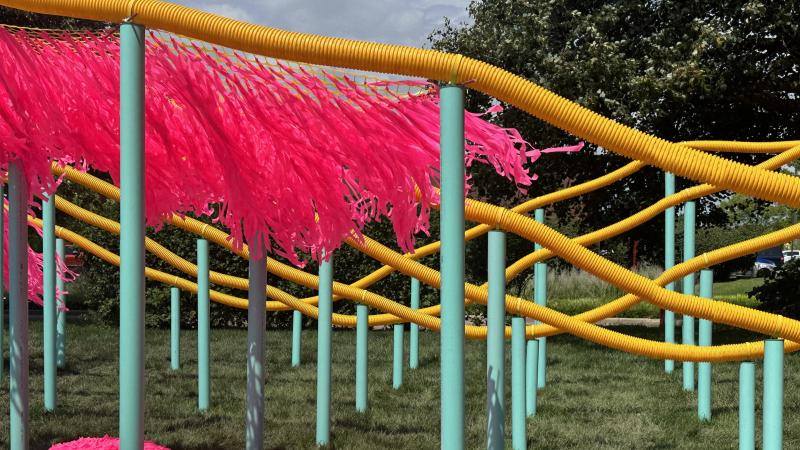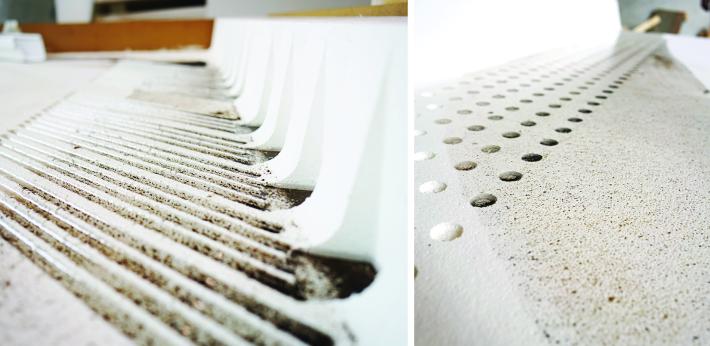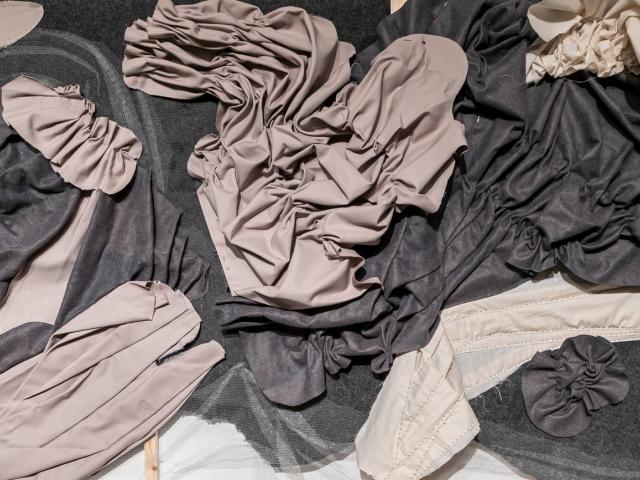Designers Speak Up About Hidden Systems
Weaving through a colorful grid of vertical pipes and beneath undulating tile drains and rain clouds, visitors to PIPE UP! experienced a vibrant and sensory experience intended to make visible the subterranean water infrastructure of urban development and agricultural production.
One of seven University Design Research Fellows selected for Exhibit Columbus, PIPE UP! is the creation of BLDS, the design team of Knowlton School landscape faculty Halina Steiner, Tameka Baba, Forbes Lipschitz, and Iowa State Associate Professor of Architecture Shelby Doyle. PIPE UP! was on display from August 15–December 2 surrounded by the legacy of modern architecture of Columbus, Indiana at the Hotel Indigo Columbus Architectural Center. The team was selected as 2022–23 University Design Research Fellows for Exhibit Columbus through a national competition open to full-time university professors whose work is rooted in design research
Made up of a standing field of 150 Charlotte Pipes, six agricultural tile drains, rain clouds made of flagging tape, and poufs representing toxic sediment, the project seeks to facilitate events and conversations about the future role of water in local riparian corridors and across the Mississippi River Watershed Basin.
The Knowlton School recently spoke with members of the BLDS team about their design process, constructing the installation, and the public’s response to PIPE UP!

Can you talk about the title PIPE UP!? The idea of speaking up and the aboveground visibility of the drainage pipes seems to suggest a message that needs to be amplified.
Forbes Lipschitz: A lot of our work is about visualizing hidden systems and parts of the built environment that people take for granted, so we started thinking about how vibrant, engaging installations can make these hidden systems more present. So, our idea was to take off-the-shelf materials that were affordable and bring them to the surface, literally to bring up the pipe to make the infrastructure speak for itself through its presence.
In the midst of the Anthropocene and climate change, many of the things we’re learning about can be incredibly disheartening and depressing, and it’s easier to tune it all out. So, how do you get people to tune in? We tried to do this through playfulness and joy and color, and then weave in the serious stuff in other ways.
I am curious about the design process. How were you able as a team to develop and evolve the design?
Halina Steiner: Tameka [Baba] and I were able to go to Columbus, Indiana, for the kickoff of the University Design Research Fellowship and be part of a symposium that weekend. While there, we looked for potential sites. There were alleyways, flat open sites, sites under tree canopy, and sites that engaged with the library. So, one of the first things we did was communicate to the rest of the team the fabric of the city and share our photographic documentation of potential sites.
We knew we were doing something about revealing hidden tributaries in agriculture and urban environments, but we didn't know what that was yet although we knew we wanted our project to tie in to some of the weaving that Tameka does. So, we just all came up with different ideas. We eventually decided we wanted a flat site that was open. We knew we didn’t want to make a solitary object; we wanted to make something that people could engage with in a field. While looking for inspiration from other projects and artwork, we worked through several iterations of the design.
Forbes Lipschitz: Building on Halina’s point, we primarily worked through Zoom meetings, Miro boards, and Google slide presentations with the preliminary concepts, and then we drew sketches and posted precedents in Miro. So, our work was mostly digital.
Tameka Baba: I think we all knew our limits about spending time on Zoom. For example, we would work about 45 minutes to an hour discussing photographs or sketches, and then we would take a break and regroup in a week or so and bring back fresh ideas. It became an iterative process of returning to the work and pushing new ideas. During these meetings, we’re doing active research and then dropping that into the Miro board and then building sketches, notes, Post-its, and links around that to develop the project. It was very collaborative and very engaging for all of us.
Shelby Doyle: We also developed detailed digital models of every single piece, and that was to help us maintain the ethos of off-the-shelf materials, and also allowed us to estimate exactly how many pieces we needed so we could manage our budget. I think without Zoom and Miro it would have been really hard to participate in this project from another university because I'm in Des Moines.
The Ohio State team was able to do some mockups in Halina's backyard to see what would happen. The physical mockups allowed us to make sure that everything could be disassembled. We noticed the sound of the flagging tape blowing in the wind, which makes a really nice noise, and which was something I don’t think we had considered. We also realized we needed to add pipe insulation due to some rattling against the ground attachments. These were some of the sensory conditions that you can't really build into a digital model. I appreciated working with landscape architects because they have different attitudes than most architects about time passing and digital precision and occupying space.

How did you intend for color to be a part of the experience of the installation?
Forbes Lipschitz: Our colors were definitely dictated by the existing color palette of the materials themselves. So, you can typically get tile drains in two different colors, sometimes three—such as black, yellow or blue—and the sewer drains come in one color, which is like a sea foam turquoise. Flagging tape always comes in bright neon colors that are vibrant and stand out. So, it was a matter of looking at the existing palette and then finding the combinations that were the most joyful, which is how we settled on the turquoise, the hot pink, and the yellow. But it was very important that these pieces were not spray painted and that everything we displayed was as you would find it from the distributor.
Given the installation’s reference to hydrology—did you design for a sense of movement or fluidity?
Halina Steiner: Yeah, so there is the vertical element of the sewer pipe that is emblematic of both a cornfield and a city grid, which is where you would find these pipe infrastructures. In addition, the top of the installation undulates, which represents both the actual topography of a landscape and also the movement of water. Also, as the installation clouds are depositing toxins in different places, they also collect where the installation gets closest to the ground. Right? So, it's abstract and reflects some of our thinking about the shape of the larger pieces of tile drain.

Can you talk about the phases of the installation’s construction?
Tameka Baba: Initially, we started in June and spent a busy week at the Knowlton School precutting and prefabbing a lot of our materials, and followed that up with another intense week in August.
At the site, it was a lot of fun, but we also had to address things that we were worried about, such as, How do you get 150 stakes into the ground? Luckily, we had volunteers from the community who said—Hey, we have the tools that you need. So, the construction process started by laying out a grid that all of our tile drains would fit into and making sure that those points were correct and accurate, and then drilling into the ground 150 stakes.
As with every well-thought-out process, you always have to account for some snags along the way—so, we would regroup, have a discussion, and bounce back from there to finish the construction. For example, after we secured the woven clouds to their touchpoints, we noticed they were sagging in the middle—so we reinforced them with pink bar. But it was a really great time, especially being able to engage with our team, our volunteers, and our students that we were able to bring along and help us with the projects.
Halina Steiner: Just to add a bit more about our volunteers and the people who helped us. Tameka had the High School Design Studio help us for an afternoon working on the poufs so they could understand how they work in the under-skeleton of the installation. We also had our two College of Engineering Undergraduate Research Fellows Maggie Chafin and Blake Chapman. Throughout the summer, we had pouf parties where students would just come in and some of our local friends came by and we would just listen to music and tie knots and people found it very relaxing. And so, we couldn't have completed this project without the larger community coming in and hanging out with us.

How well did your design plans align with the actual installation? Were any alterations or adjustments necessary?
Halina Steiner: There is an aerial shot that was taken from a drone and it looks pretty much identical to one of the renderings that we made. It was quite eerie, actually. So, it all came together pretty smoothly. I mean, there were hiccups, but it got built in the time that we thought it would take us. It came down in the time that we hoped it would take us. I think we were prepared, but we were also prepared for things to go wrong and to pivot if necessary. But I think that's also part of anything that you're doing that you've never done before in terms of construction.
Shelby Doyle: I think part of the benefit of working with the field condition is that it operates through the collective of all of the pieces, and so you can add and subtract and adapt quickly on site. At some point, we removed an entire row from the design because of the tree canopy. That was possible because it wasn't designed as an object, which also speaks to the way that infrastructure can be totalizing and can happen over such a broad territory that it doesn't all fall apart because one piece was missing. So, I think there's something there about the attitude of collective making that is built into a field condition.

Did PIPE UP! perform the way you hoped it would? How did visitors respond to the installation?
Forbes Lipschitz: We saw lots of evidence of people using it in ways that we had hoped for. On social media, there were a lot of selfies immersed in the clouds of the installation. I think people really appreciated the movement of the installation so we saw a lot of videos. It was really amazing to see on Instagram that a high school student had their senior yearbook photos taken there.
Something that I hadn't anticipated was how the poufs would be treated as puddles because—what do you do on a puddle? You jump on it, and I think we just imagined people sitting on them. But kids loved jumping from one to the other and this we hadn't expected. And of course, that led to other forms of wear and tear that we hadn't necessarily accounted for but the poufs still held up very well.
Tameka Baba: To echo Forbes, we got a lot of great responses, especially on social media, about how people were enjoying the colors and the movement of the installation. PIPE UP! brought people a lot of joy, which brought us a lot of joy. Just last week we discovered a Facebook post where someone created a collage of different images from our site. So, even though it's been down for about a month and a half, people are still talking about it, which is really special to see.
Halina Steiner: When you have an installation and there's a series of other installations around, you hope that people are drawn to yours and that they want to spend time there. I think one of the nice experiences of PIPE UP! goes back to the poufs, which if you lay on, you can experience the clouds moving in the wind, which really animated the installation and provided a movement that you couldn’t control.
Shelby Doyle: I think it was an exciting opportunity, especially coming out of the isolation of the pandemic, to engage in a project that was community-facing. Also, it was an opportunity to take urgent topics like climate change and water quality and use interdisciplinary design between architecture and landscape architecture to create a really joyful space. I think what was fascinating about this project was the joy that it seemed to bring out in people, which then served as a conduit to talk about some of the more serious, urgent, and challenging aspects of how water is managed in the Mississippi River Basin.
Funding and support for PIPE UP! was provided by Landmark Columbus Foundation, Columbus Architectural Center, Hotel Indigo, Knowlton School, College of Engineering at The Ohio State University, Iowa State University College of Design, Baughman Tile Company, OSU Landscape Architecture students Blake Chapman and Maggie Chafin, students from the Center for Architecture and Design High School Design Studio, and pouf party volunteers from the Columbus, Ohio community.





